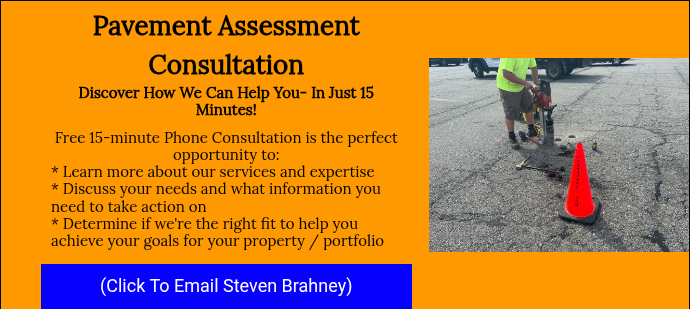Milling & Paving vs. Overlay Resurfacing: What Every Commercial Property Manager Needs to Know
When it comes to extending the life of your parking lot, two of the most common resurfacing methods are milling & paving and asphalt overlay with transitional milling. On the surface, both options may appear similar—new blacktop, smoother driving surface—but the truth is, each method comes with distinct advantages, drawbacks, and long-term implications, especially when it comes to drainage, elevation, and structural integrity.
Below, we will discuss how you, as a commercial property owner/manager, board member, maintenance professional, or director of maintenance, will be able to determine if your asphalt parking lot is a candidate for asphalt milling and paving or resurfacing and verify the information the asphalt paving company is telling you.
And just so you’re aware, FixAsphalt.com has been in commercial paving and parking lot maintenance since 2001. We quote asphalt, concrete, pavement repair and pavement asphalt seal coating projects daily, so all of this info is from real projects quoted in 2024-2025.
NOTE: This article has been read, edited, and approved for publishing by Steven Brahney, who has 30+ years of asphalt experience maintaining and reconstructing asphalt parking lots for commercial properties in every state on the East Coast.
Let’s get started!
At FixAsphalt.com, we’ve worked on every type of asphalt resurfacing, milling, and paving projects across New Jersey, Pennsylvania, and Delaware. Here's what every commercial property owner, property manager, and facility manager should understand before approving their next paving scope.
Option 1: Asphalt Milling & Paving (Full-Depth or Surface Milling)

What it is:
This method involves removing the top layer (or multiple layers) of existing asphalt down to a specified depth—typically 1.5" to 3"—and then replacing it with new hot mix asphalt. This process restores the pavement to its original elevation and addresses surface-level damage.
✅ Advantages
-
Maintains Existing Drainage Patterns
Because milling restores the original elevation, curb lines, ramps, and transitions remain functional—no water pooling or tripping hazards. -
Prevents Height Build-Up
Milling avoids layering new asphalt on top of old, which can lead to improper tie-ins and structural elevation issues at curbs, sidewalks, and ADA ramps. -
Better Bonding & Longevity
New asphalt bonds better to a milled surface, reducing the risk of delamination and extending pavement life. -
Identifies Subsurface Issues Early
Milling exposes base problems (e.g., alligator cracking, base failure) that can be addressed before paving.
❌ Disadvantages
-
Higher Cost Upfront
Milling adds equipment and labor costs along with millings disposal costs compared to a simple overlay. -
Not a Cure-All for Structural Failures
If the sub-base is failing, milling may not solve the root cause without additional repair work.
Option 2: Asphalt Overlay (1.5” or 2”) with Transitional Milling Only

What it is:
A layer of new asphalt (typically 1.5–2 inches thick) is installed directly over the existing pavement. Transitional milling is performed only around curbs, catch basins, and transitions to blend elevations.
✅ Advantages
-
Lower Initial Cost
Overlaying without full milling is often 25–35% less expensive upfront. -
Faster Turnaround
Less equipment and prep time mean shorter project duration. -
Temporarily Improves Aesthetics & Ride Quality
Makes an old lot look new—temporarily.
❌ Disadvantages
-
Drainage Compromise
Every inch of overlay raises the elevation of the pavement. Water that used to run off may now pond against curbs, sidewalks, or entrances—leading to ice hazards, moss, and premature failure. -
Improper Tie-Ins & ADA Violations
Without full milling, curb heights may be reduced and ADA transitions may no longer be compliant—potentially exposing property owners to liability issues. -
Delamination Risk
New asphalt applied over a polished or oxidized surface may peel off over time if not properly cleaned, tack-coated, and installed. -
Traps Existing Defects
Overlays cover up problems like alligator cracks, base failure, or drainage issues, without solving them. Cracks will reappear within 1-2 years. Crack sealing is recommended to delay reflective cracking.
The Drainage Danger That Costs Thousands

One of the most overlooked but most damaging consequences of a 1.5"–2" overlay is improper drainage.
We’ve seen overlays that looked fine on day one but, within a year, water began ponding against concrete aprons, running behind catch basin collars, and freezing in dangerous spots. Why? Because the elevation changed, and water had nowhere to go.
If water can’t drain off your pavement, it saturates the base layer, accelerates freeze-thaw damage, and shortens the life of your new overlay by 50% or more.
So Which Option Is Right for Your Property?

-
If your lot has good structure, proper elevation, and minor surface wear, an overlay may be a cost-saving option—but only with proper prep and site analysis.
-
If your lot has drainage issues, prior overlays, or base-layer fatigue, milling & paving is the only option that protects your long-term investment.
Here is a quick video that discuss's the potential issues when performing an asphalt overlay vs. a mill and pave
FixAsphalt.com’s Approach: Engineering Over Guesswork
At FixAsphalt.com, we never “guess” which method is best. Our process includes:
-
Full pavement condition assessments
-
Elevation & drainage analysis
-
Strategic core sampling (when needed)
-
Drainage testing the parking lot after a rain event
- Inspecting and verifying the ADA for compliance
We treat your pavement like the capital asset it is—not just a surface to be blacked out every few years.
Bottom Line
✔️ Overlays without milling are often short-term fixes that create long-term problems.
✔️ Milling & paving provides the best path to long-term durability, proper drainage, and compliance.
✔️ Every property deserves a solution based on facts—not price-driven shortcuts.
Have questions about your property?
Reach out to FixAsphalt.com for a free, no-obligation needs analysis. We’ll walk your site, take photos, and explain the best solution—without the sales pressure!











Leave a Comment